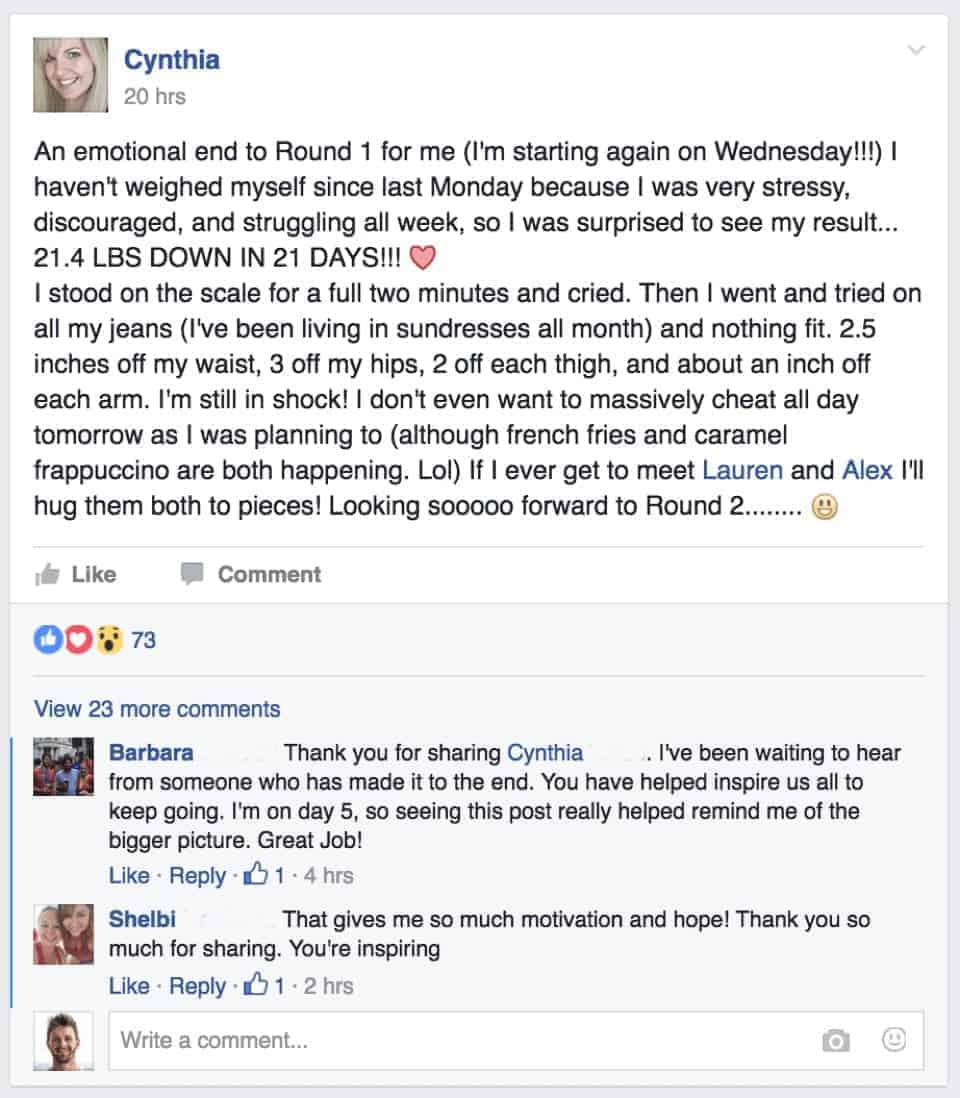Creating and then learning how to sell products on your blog (successfully) can be a scary thing. Imposter syndrome is real and I think it’s something that everyone feels to some extent.
It can be tough to put yourself out there in a totally new way. To put your name and face on a product that is meant to teach others how to improve something in their lives.
A lot of thoughts flood our brains, like:
“Why would anyone buy from me?”
“Am I even qualified to do this? I’m not an expert.”
“What if no one buys it?”
I felt all of those things too. The stress and tension I felt during the week of releasing my first product was palpable.
Upon further reflection, I realized that a lot of this stemmed from the fear that nobody would want it. That I’d never figure out how to really make money blogging and this endeavor would fail.
But I sucked it up and pushed through those fears and doubts. I was determined to make this work. The only alternative was to go crawling back to my old job, and that wasn’t going to happen.
The First Product Launch
The first product that an eBook on yoga for weight loss for my first health blog.
The launch of that eBook coincided with friends coming to visit. So, after finishing the product, building and setting up the sales page, writing the sales email, and the rest of the set up, it was go time.
I checked my email notifications on my phone probably every 7 minutes or so that entire weekend.
I was waiting for that “Stripe Payment of $37” to come through on my phone. Stripe is the third-party payment processor used to collect payments on the sales pages.
Sadly, not a single sale came through that weekend. I was bummed and those fears were realized.
But then I logged into that Stripe account when I got home — to find out that I apparently had disabled email notifications for payments.
SALES!!!!!!
I don’t want to be too overdramatic here, but I could feel the physical relief from seeing those first $37 payments. It washed over me like a tidal wave. Mimosa celebration was in order.
Now, this wasn’t the first bit of money that my business partner and I had made with this blog. We had made some already through selling affiliate products.
But selling your own product to your audience… That’s a whole different ballgame and a whole different level of success.
The money felt more real in a weird and unexpected way. It paved the way for a new connection and appreciation for the business and the work that we put into it every day. And it wasn’t just the money. It had everything to do with what the sale represented…
- All the late nights
- The fights and disagreements that really just spurred from fear
- The insane decision to quit our jobs before we were making any money
It all began to feel worth it — like it was finally paying off. This was the first taste of REAL success, and I want to show YOU exactly how it was done.
1. Set the right expectations.
It may seem weird, but this step may be the most important.
Selling products to people you don’t know isn’t easy and it starts with having confidence in yourself and the knowledge that you have to share with the world.
Yeah, there are a lot of two-bit peddlers selling half-baked products out there. And yes, a few of them make some money. But they aren’t the ones on top.
They don’t understand (or don’t care) that their knowledge can actually change the world. They care more about money. Here are a few mindset shifts we have learned that helped us succeed.
Remember that EVERYONE has doubts.
This is why I started out with some of my background story. I told you about some of the feelings I had when we started creating our first product:

- We’re not good enough.
- It’s going to fail like our first product did.
- Nobody wants this information or will pay for it (it’s free on the Internet like everything else!).
We were literally moments away from not making our product because of these fears and doubts.
I will never forget that moment because of how strong the emotions were. The courage to push forward despite these fears stemmed from the idea: “What’s the worst that can happen?”
We had already quit our jobs and essentially pledged our commitment to the business to see this thing through. We had to know that we tried everything.
And man am I glad that we kept moving forward.
Here is the second truth…
People WANT solutions to their problems.
Everyone has problems. Everything from not being able to keep their house plants alive to not being able to train their dogs… or goats…
There is also a lot of information on the internet. Too much, actually. People will pay for an organized and timely solution to their problems.
There is no reason to feel weird about selling to people because you’re HELPING them (assuming your product really does work). You’re delivering results.
And the other thing is… People work harder for the things that they pay for. They usually have a higher commitment to doing something with the information that they paid for.
And then… all of your fears and concerns will be validated when people start thanking you for your product and their results.

Digital products (vs. physical) have a lot of upsides.
Here are some of the top reasons why selling digital products is the way to go:
- No shipping involved. Physical products need to be stored and shipped. Even if you’re not the one doing this, it’s still an extra step to be managed.
- High-profit margins. Other than some transaction fees, software costs, and maybe some marketing costs (if you use ads), the profits are mostly yours.
- Automated and passive income. Once you create the products and the systems that sell those products, the money is pretty darn passive.
- Immediate gratification. The downside is that people love to have products they can hold, but the upside is that they can get started using your product or solution IMMEDIATELY. People love that kind of instant gratification.
- Less time to develop. You can create them in a lot less time than it takes to develop or create physical products.
- Fewer costs to develop. Because it’s mostly just your time that goes into creating a product (plus maybe some minor software costs), it’s a lot cheaper to produce than a physical product.
Those are just a few of the top reasons that I think eBooks and online programs and courses are the way to go when it comes to earning serious income with your blog.
2. Focus on building the relationship FIRST.
I call this learning how to sell ice to Eskimos.
Let’s pretend like your best friend ran up to you right now and asked you for $100 — no questions asked. They said it was very important and needed it RIGHT NOW!
You’d give it to them, right? That’s because you trust them.
Sales are about trust. Another easy analogy to relate this to is sex.
Let’s say you’re walking up to your porch and about to enter your home when some guy off the street walks up and asks you to sleep with him…

You’d probably think:
- This guy is a creep…
- Where’s my pepper spray?
- HELP!
And my hope is that you wouldn’t proceed.
Now let’s pretend the same guy isn’t some weirdo on the street but is someone you’ve just recently met at your local grocery store. You’ve been on a few dates, have tons of fun with him, and all your friends gush about how much they love him.
You’re on your porch again, and he asks if he can come in… Moral turpitude aside, you’d probably say yes, correct?
The difference is the trust he has built with you, and building trust is all about proper sequencing.
Just like with dating, your relationship with your reader must grow and progress before they trust you enough to give you their money.
Ask too soon, and your reader may slap you in the face with a nasty comment. Ask at the right time, and they will gladly “go home” with you and love every second of it (if you treat them right).
3. Generate ideas and PLAN.
Okay, it’s time to start DOING! This next phase involves forming your idea and planning out your timeline to finish the product.
Before you get started actually creating, you should first create a solid plan for your product so that way you aren’t fumbling throughout the entire thing.
Examine your competitors, your current audience, your most popular content, and whatever other data you have at your disposal. Look at what is working for others in your niche, analyze your own most popular content to see what YOUR audience is most interested in, and start drawing some conclusions.
These conclusions should help you ultimately form a hypothesis for a solution that your audience wants and needs most. Lastly, think about what that solution looks like and start planning a timeline to complete the project.
4. Create your outline before you dive in.
A detailed outline of a product is a more involved process than most of you would imagine.
A great outline contains:
- A well-thought-out product name
- A great headline to complement that product name
- All the content broken down into modules, lessons, or other sections
Here are a few tips to help you out with this part. Your product name should be fairly short and somewhat descriptive of what the product does.
You can try to get cutesy with your product name if you want, but make sure people know what type of product it is by the name alone. This will make it more recognizable.
Next up is the headline.
This is probably one of the most important things that you will write. This is very similar to the headlines of your articles and the subject of your emails. This is your hook to get them reading more.
Make sure that you address either the problem or the solution in your headline.
Lastly, you should create a thorough outline of what content you want to include in your product. I usually write this in a Word document with different “modules” for the main topics I want to cover and then “lessons” within the modules for more specific talking points about each topic.
5. Write Your Rough Draft
How do you eat an elephant?
One bite at a time.
Once you know what your product is going to be, what you want it to look like, and what problem you want to solve with it… It’s time to START.
This is by far the most daunting part of the project, and it’s a daily attack until it’s done. Some days, you may get a few hours done, and some days, a few minutes. But every day, you need to wake up with that draft on your mind.
YOU DO NOT want this process to extend over multiple months. It will loom over your head at every turn and become a constant stressor on your system.

Trust me, I have created almost ten different products now, and “product creation mode,” as I call it, can be VERY stressful.
Don’t drag it out! Attack that draft until it gets done. You’ll be over the moon when it is! This will look different for everyone depending on the type of product you are creating.
If you’re writing an eBook, it will just be a whole lot of WRITING every day. If you’re creating an online course, it’s likely going to be a combination of creating presentations, recording videos, and writing lessons.
But no matter what you’re creating, it’s just about content creation — every… single… day… until it’s done.
6. Finalize and publish your product.
Once you’re finished with your first rough draft, it’s time to start finalizing your product!
The first step here is to proofread everything at least a couple of times. Use a free tool like Grammarly, proofread it yourself, and then get someone else to put their eyeballs on it for a second opinion.
The more familiar you are with the content, the more likely you will be to read faster and miss grammatical errors.
Once you’ve done this, you need to think about where and how you will sell your product.
My favorite platform for selling products is Kajabi. This is what we use to sell our signature course, Six-Figure Blog Builder.
Clickfunnels is another great platform to sell eBooks.
After you have built your sales page, checkout form, and thank you page, it’s time to test everything. You should do an entire walkthrough as a customer and purchase your product to make sure that your buttons work, your checkout page and order forms work, the right emails are sent, and the product is delivered.
It’s really easy to overlook small things in the setup, so this step is very important. It also helps to get a friend or partner to go over the sales page again to look for errors.
Once everything has been tested… Congrats! Your product is ready to be sold!
7. Learn how to sell products on your blog.
I’m going to be honest with you. Creating the product is the EASY part of this process. Learning how to market and sell your product is a whole different ballgame.
My first product failed miserably because I tried to dive in headfirst without any guidance whatsoever. But here’s the interesting thing about that experience…
The product wasn’t the problem. It was that we had absolutely no idea how to sell it.
We didn’t have any experience. We didn’t know what we were doing. You can’t just link a product on your website and wait for the sales to roll in. It doesn’t work that way.
You have to create sales-centered content and funnels designed to sell your product.
It took us several months of trial and error to start really getting the knack of the whole “sales and marketing” thing. And honestly… It’s actually quite fun once you get the hang of it!
If you enjoyed this article on how to create and sell products on your blog or have any questions, please leave them in the comment section below!
Wow! Thank you very much for this! It’s really helpful, especially when it comes to making money from blogging. Thank you so much!
You are most welcome! Glad you found it helpful!
i appreciate your article as i struggle to create my first digi kit along with developing my website and brand. you hit almost all my own qualms and provided ways to address them – why is it always easier to help and advise others than it is to apply that to our own endeavors? i mentioned this to a friend, and she said i’d given her almost the same advice as you wrote here!
well, i definitely appreciate your article and the reinforcement that i might actually know what i’m talking about!
You are so welcome! Glad we could confirm what you already know. Now it’s time to act! 😉
Thank you for your information, It is a very useful article
You are so welcome!
woah!thank you so much for this!this really helps me a lot… especially when it comes to earnings in blogging…thank you so much!
You are most welcome!
Hi I’m Rita from Wisconsin
I’m 55, and need help with setting up my blog, I have my business ready to put on line but have know ideas how to go from their , my daughter Sheryl Romanowski and I bought the full package but I’m wondering if I have to buy my own. There is a group of us that want to learn so we can help and support each other
I’ve never blog before and my daughter showed me Pinterest while I was taking care of my mother with cancer, she past a year a go so I’m starting a new page. Let get going
I have a very strong personality, and very little filters. Black and white, no greys
Hey Rita. It’s totally fine for you and your daughter to go through the course together 🙂 Be sure to join the private facebook group if you haven’t already done so for additional support.
Thank you guys so much. I am still in the planning phase for my blog, hoping to get it out of my head and onto the interwaves soon. I actually thought there was no way I could come up with a product to sell, and yet here I am now, planning to draft an ebook (even before my blog takes flight) and wait for some feedback. You two are awesome and an inspiration. Thank you again.
Great to hear, Kriss! Keep us updated on your progress 🙂
Really informative article, thank you for sharing! I know you’ve talked about launching your own product too early… but at what point exactly would you suggest launching your own?
Hey, Kate.
We recommend creating your own products after you have successfully sold some affiliate products on a pretty consistent basis. This is how you will learn what your audience is interested in as well as HOW to sell to them. You can read more about it in our post “How to Make Money Blogging”.
Bookmarked this post and enrolling in the free e-course!
I have to say guys, I have watched you grow over the past and you really are growing as people and as business owners of a blog. Every time you present something it gets better and I feel like I have grown if not with confidence watching you do your thing. I would like to say thank you for the ride and thank you for the Amazing Internal Focus I have to give it a try. It has been a dream to blog and to create finance from home so I can spend more time with my family and not struggle from month to month. Keep up the Fantastic work and I will definitely be a Fan for years to come……
Thanks so much, Rob! We definitely don’t consider ourselves much of “experts” because we are constantly learning as well. The learning never stops and we do the best that we can with what we’ve got. I’m so glad that our growth process has been transparent enough for you (and others I hope) to be relatable! Thank you for sharing this comment!! 🙂
I would love to see a post on how you give access to the e-books/courses after they purchase, and also what program you use to sell them on your website. Loved this article, SO helpful 🙂 Keep it up!
Hey, Courtney! We provide all of this information plus a LOT more about the process in our full course, called Six Figure Blogger. You can find it on our website on the Courses page.
Brilliant guide, guys. Very, very helpful stuff!
I’ve just got to the point with my website where creating a digital course is the most logical way to go forward. I’m now in the process of talking to my subscribers and validating the idea. Exciting times! 😀
That is exciting! Congrats, and good luck! Thanks for sharing, and we’re so glad that we could help! 🙂
Loved every line of this article, guys!
Thanks for putting in the work and taking the time to share this.
I personally appreciate all the hard work and energy that goes into this daily online hustle – the one we’ve all come to love called “Create and Go.”
Blessings to you both,
Robert
Thanks so much for the kind feedback, Robert! We really appreciate it! 🙂
The pleasure is all mine, guys! 🙂